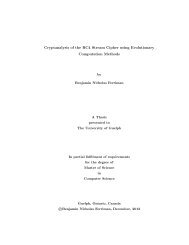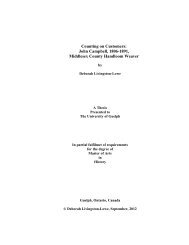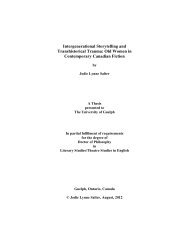THESIS - ROC CH ... - FINAL - resubmission.pdf - University of Guelph
THESIS - ROC CH ... - FINAL - resubmission.pdf - University of Guelph
THESIS - ROC CH ... - FINAL - resubmission.pdf - University of Guelph
Create successful ePaper yourself
Turn your PDF publications into a flip-book with our unique Google optimized e-Paper software.
increased in size. At fiber concentrations below 0.5% w/w SMF/SPI, the appearance <strong>of</strong> flakes<br />
was minimal to non-existent. Upon FTIR analysis <strong>of</strong> these fractions, they were found to be<br />
aggregated cellulose fibers. Further analysis on the protein melt from the screw flights within the<br />
extruder showed that large fragments could be found loosely adhering to the bulk SPI melt. As<br />
seen in Figure 6.2a, the large fractions were mainly concentrated against the barrel walls and<br />
surfaces <strong>of</strong> the screw. No signs <strong>of</strong> chemical association were observed as clear separation <strong>of</strong><br />
the fragments from the bulk SPI melt was apparent. This phenomenon again was dependent on<br />
the concentrations <strong>of</strong> fiber added to the mixture. With low additions <strong>of</strong> fiber (0.25 and 0.5% w/w<br />
SMF/SPI), few to no fragments were seen inside the extruder barrel.<br />
a<br />
Figure 6.2: Presence <strong>of</strong> cellulose rich agglomerates observed throughout the process <strong>of</strong><br />
extrusion. a) Aggregate formed inside the extruder barrel wrapping around screw. b) Clumps seen<br />
through strand formation after compounding. c) Aggregated fragments embedded in<br />
SPII/cellulose blend films at high fiber loadings.<br />
b<br />
Progressing to extrusion findings, the presence <strong>of</strong> cellulose rich domains was also<br />
observed. Large particles were embedded randomly throughout extruded films (Figure 6.2c).<br />
The phenomenon was exaggerated with higher fiber concentrations (1.0% and 2.5% w/w<br />
SMF/SPI). However at concentrations <strong>of</strong> 0.5% w/w SMF/SPI and below, the presence <strong>of</strong> these<br />
69<br />
c

















